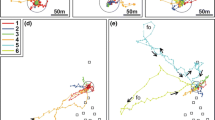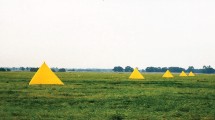Abstract
Honeybees were trained to find sugar water in the middle of an array of two landmarks of different colours. Unrewarded tests compared searching on the training array with searching on rotated arrays. On rotated tests, a system using the angles between landmarks would continue to search in the middle. A system using vectors to individual elements would search at locations outside the rotated array at which the distances and compass directions to a subset of landmarks matched. Results indicated that bees used both elements and interlandmark angles, but they relied most on one favourite landmark element. Results support the template model of landmark use in honeybees, with the minor parametric modification that weights given to different elements may be unequal.
Similar content being viewed by others
Author information
Authors and Affiliations
Additional information
Received:6 July 1998 / Accepted after revision:7 December 1998
Rights and permissions
About this article
Cite this article
Cheng, K. Landmark-based spatial search in honeybees. I. . Anim Cogn 2, 73–78 (1999). https://doi.org/10.1007/s100710050026
Issue Date:
DOI: https://doi.org/10.1007/s100710050026




